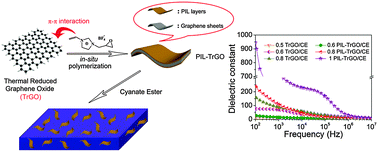Building a poly(epoxy propylimidazolium ionic liquid)/graphene hybrid through πcation–π interaction for fabricating high-k polymer composites with low dielectric loss and percolation threshold†
Abstract
Sustainability urgently asks for low dielectric loss and a low percolation threshold (fc) while developing high dielectric constant (Hi-k) conductor/polymer composites. In this work, a novel hybridized graphene (PIL–TrGO) was first reported using a two-step process, including the decoration of an epoxy functionalized ionic liquid (IL) on the surface of thermally reduced graphene oxide (TrGO) through πcation–π interaction, followed by in situ polymerization of the IL. The DC conductivity of the PIL–TrGO hybrid is as good as that of TrGO. Then, different loadings of PIL–TrGO were added into cyanate ester (CE) to prepare a series of composites; the TrGO/CE composites were also prepared for comparison. Different from TrGO, the PIL has a large amount of epoxy groups, which guarantees good dispersion of the hybridized graphene in CE matrix, and thus provides the base for transferring the outstanding electrical properties of graphene to the composites. When the loading of fillers approaches the percolation threshold (fc), the dielectric constant and loss at 100 Hz of PIL–TrGO/CE composites are about 13 and 0.57 times that of TrGO/CE composites, respectively, while the fc of PIL–TrGO/CE composites is still as low as 0.94 wt%. The dielectric mechanism was studied by discussing and simulating impedance spectra, and the results show that PIL–TrGO/CE composites possess more micro-capacitor structures than TrGO/CE composites; moreover, the cation–anion charge layers on TrGO surfaces enhance the Maxwell–Wagner–Sillars polarization between PIL–TrGO hybrid and the CE matrix, and then markedly increase the dielectric constant of composites. PILs coated on graphene surfaces act as electron insulative layers and thus decrease dielectric loss induced by the leakage current between conductive carbon layers.


 Please wait while we load your content...
Please wait while we load your content...